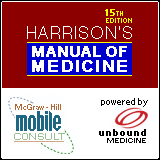 |
|
|
Harrison's Principles of Internal Medicine has been a medical best seller for decades, so it was a logical choice for publishing in a handheld format. I originally used a product by Handheldmed based on the 14th edition. The 15th edition comes from Unbound Medicine. The switch to a new CogniQ Reader (A mobile knowledge management platform that integrates handheld devices with the Web) resulted in some subtle changes, but it remains a great first reference for medical information.
Finding the appropriate subject is usually a quick process. I prefer to use graffiti to enter the first letters of my term of interest in the topic guide. When the software figures out the section I want, it's one tap away. From there the information is organized into clinical manifestations including signs and symptoms, differential diagnosis, lab findings, and pathophysiology. The latter category is a particular strength of Harrison's Manual, making it an especially suitable resource for students and teachers. There are also treatment summaries, but they tend to be less detailed than some other clinical resources. One of the ways Harrison's is different is its use of full text material. The information is provided as paragraphs of complete sentences, which means much more scrolling through screens of text. Many experienced clinicians prefer a more terse presentation of content, as bullets or "Pearls" like 5MCC and PEPID. A smaller font can be selected to get more content per screen. Harrison's Manual has no diagrams, tables or figures. The Find function was always a bit problematic. In both the original Handheldmed version and the first CogniQ readers this was a lengthy process, requiring several minutes on a slower processor. I found little use for this functionality in either version. The latest build, 2.14.28, appears to have dropped the Find function altogether. I won't miss it a bit. This product is also available in several bundles called Harrison's On Hand You can get the manual with LexiComp's excellent PDA drug reference, or you can go for a package that provides access to the full internet version of Harrison's. Harrison's Online has the diagrams and tables cited in the PDA text version. Both the latter include live updates. Offline queries are enabled through a personal web library service. The Handbook of Medicine retails for $69.95 US here at PDA cortex. Prices for the bundles are currently $139 and 249. The requirements to run Harrison's are modest, only 1.2 M of memory for Palms, and OS 3.x or greater. It also runs on Pocket PC 2000 or 20002 requiring 1.5 M of space. Color is supported on both devices. The software can be run from Pocket PC memory cards but not those for Palm devices. This is annoying, as this feature was enabled with the previous Handheldmed version. I have used it on a Clié running OS 5 with no problems. I also had occasion to contact Unbound Medicine technical support when migrating my subscription over to my new PDA. To my surprise, my e-mail was answered within a few hours, on a Sunday afternoon, with a solution to my problem. This was impressive. Harrison's Manual of Medicine is authoritative and easy to use. It is an excellent choice for those with an interest in pathophysiology and is a valuable clinical tool for students and teachers alike. It takes much less RAM than the more comprehensive products, but does not run on Palm OS memory cards. It does require lots of scrolling. Stewart can be reached by email.
|
|||||||||||||||


